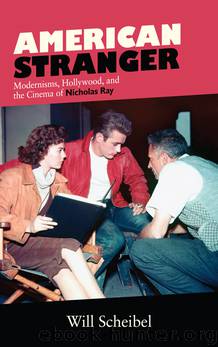American Stranger by Scheibel Will

Author:Scheibel, Will
Language: eng
Format: epub
Publisher: State University of New York Press
Published: 2017-05-14T16:00:00+00:00
Ray’s figure looms so large that he is sorely missed when he is not onscreen. Despite his compelling presence, however, his role has more to do with distanciation than identification. Home does not present a linear plot, but a series of vignettes, or, more accurately, digressions and interruptions reflected through a mise-en-abyme that come to dominate the film. Attempts to summarize the film in narrative terms seem inadequate, as its organization seems based on affective connections rather than traditional structures of cinematic rhetoric, and the film defies generic categorization of any recognizable kind. The brief script outline, which Ray drafted with Susan, focused on “the vulnerability of a new professor—an amateur in teaching, just as his students were amateurs in film” (Lederer 62). Perhaps a more precise way to describe Home is the “making of” this very film.
Densely self-reflexive and intertextual, Home constantly lays bare its own mode of production, destroying not only the rectangular frame through Ray’s “mimage” process, but also destroying Hollywood’s system of narrative transitivity (derived from continuity-based editing, cinematography, and mise-en-scène). The film violates the invisibility and transparency we would expect from a Hollywood production, built on the illusion of unity and seamlessness, and it deliberately confuses everyday life perceptions of space and time. Multiple images also create multiple diegetic spaces. The heterogeneity of Home enables a composite, contradictory system of signification, while foreclosing a coherent subject position for the spectator. If there is any goal-oriented action to speak of, it is the making of the film itself. Since the film was never technically completed, it remains profoundly open-ended, foregoing the harmonious closure of classical storytelling. The result achieves a sensation of both heightened reality and estrangement, challenging the spectator to think about, question, and possibly resist the film text. This provocation purges the aesthetics of commercial entertainment through a confrontational spectator address, while fully realizing the always modernist trajectory of Ray’s cinema.
As the film’s auteur, or structuring author, and, simultaneously, its anti-auteur or agent of deconstruction, Ray is responsible for many of these formal destabilizations. In his memoirs, he wrote, “The professor-director concentrated on de-imagizing himself as a Hollywood director successfully enough to gain the confidence of his students” (Interrupted 204). This production awakened the political consciousness of his students, who had “retired from the conflicts of the late ’60s,” Ray reflected, “and submerged themselves in what they thought was a sage and serene womb, where no outside voices could be heard, least of all that of a Hollywood director” (204).
Ray described the film not as a documentary, but as “a documentation,” or, “a feature-length color film of the history of our youth during the past few years” (204). Moreover, the experience of the film unsettles the implied spectator out of his or her complicity with the conservative textual politics of the Classical Hollywood style in which he or she is sutured. For instance, Leslie’s confession to Ray about her prostitution experience at first appears as though we are witnessing a behind-the-scenes interaction between director
Download
This site does not store any files on its server. We only index and link to content provided by other sites. Please contact the content providers to delete copyright contents if any and email us, we'll remove relevant links or contents immediately.
| Dance | Individual Directors |
| Magic & Illusion | Reference |
| Theater |
Call Me by Your Name by André Aciman(20371)
Ready Player One by Cline Ernest(14521)
How to Be a Bawse: A Guide to Conquering Life by Lilly Singh(7384)
Wiseguy by Nicholas Pileggi(5669)
The Kite Runner by Khaled Hosseini(5082)
On Writing A Memoir of the Craft by Stephen King(4863)
Audition by Ryu Murakami(4840)
The Crown by Robert Lacey(4722)
Call me by your name by Andre Aciman(4613)
Gerald's Game by Stephen King(4571)
Harry Potter and the Cursed Child: The Journey by Harry Potter Theatrical Productions(4439)
Dialogue by Robert McKee(4321)
The Perils of Being Moderately Famous by Soha Ali Khan(4169)
Dynamic Alignment Through Imagery by Eric Franklin(4115)
Apollo 8 by Jeffrey Kluger(3635)
Seriously... I'm Kidding by Ellen DeGeneres(3575)
The Inner Game of Tennis by W. Timothy Gallwey(3575)
How to be Champion: My Autobiography by Sarah Millican(3554)
Darker by E L James(3475)
